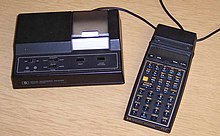HP-41C

HP-41CX with magnetic card reader and thermal printer
|
|
| Type | Programmable scientific |
|---|---|
| Introduced | 1979 |
| Discontinued | 1990 |
| Calculator | |
| Entry mode | RPN |
| Display type | LCD fourteen-segment display |
| Programming | |
| Programming language(s) | RPN key stroke (fully merged, Turing complete) |
| Memory register | 63 .. 319 |
| Program steps | 441 .. 2233 |
| Interfaces | |
| Ports | four vendor specific |
| Connects to |
micro-cassette via: floppy disk via: PC via one of: |
| Other | |
| Power supply | four size N batteries or HP 82120A rechargeable battery pack |
micro-cassette via:
floppy disk via:
PC via one of:
The HP-41C series are programmable, expandable, continuous memory handheld RPN calculators made by Hewlett-Packard from 1979 to 1990. The original model, HP-41C, was the first of its kind to offer alphanumeric display capabilities. Later came the HP-41CV and HP-41CX, offering more memory and functionality.
The alphanumeric LCD screen of the HP-41C revolutionized the way a pocket calculator could be used, providing user friendliness (for its time) and expandability (keyboard-unassigned functions could be spelled out alphabetically). By using an alphanumeric display, the calculator could tell the user what was going on: it could display meaningful error messages ("ZERO DIVIDE") instead of simply a blinking zero; it could also specifically prompt the user for arguments ("ENTER RADIUS") instead of just displaying a question mark.
Earlier calculators needed a key, or key combination, for every available function. The HP-67 had three shift keys; the competing Texas Instruments calculators had two (2nd and INV) and close to 50 keys (the TI-59 had 45). Hewlett-Packard were constrained by their one byte only instruction format. The more flexible storage format for programs in the TI-59 allowed combining more keys into one instruction. The longest instruction required eleven keypresses, re-using the shift keys four times. The TI-59 also made use of the Op key, followed by two digits, to access another 40 different functions. But the user had to remember the codes for them. Clearly, a more convenient and flexible method of executing the calculator's instructions was urgently needed. The HP-41C had a relatively small keyboard, and only one shift key, but provided hundreds of functions. Every function that was not assigned to a key could be invoked through the XEQ key (pronounced EXEQTE — "execute") and spelled out in full, e.g. XEQ FACT for the factorial function.
...
Wikipedia
